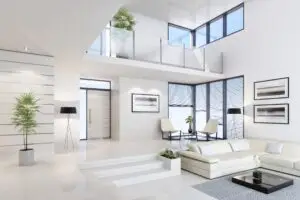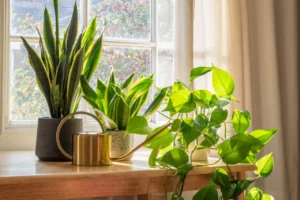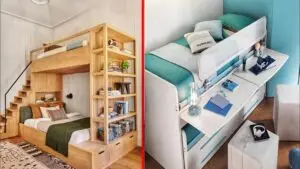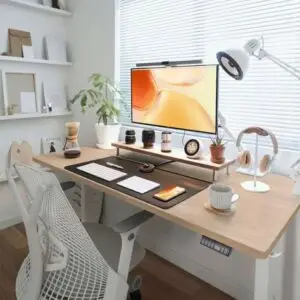Modern home décor is about more than trends. It’s a lifestyle that mixes comfort with clean design. In today’s homes, every detail matters — from the colors you choose to the lighting you use. A well-designed modern space feels open, functional, and calm.
In this guide, you’ll explore the core principles of modern décor, learn how to choose colors, arrange furniture, and create beautiful spaces that reflect your life. Whether you live in a city apartment or a large house, you’ll find practical steps and style ideas to build a home that feels modern yet warm.
1. The Core Principles of Modern Interior Style
1.1 Simplicity & Clean Lines
Modern décor values simplicity. Straight lines, uncluttered layouts, and clear visual balance define the space. Avoid excessive decoration or furniture that feels heavy. Every piece should have purpose and form.
1.2 Functionality & Purpose-Driven Design
Modern interiors work for you. Furniture should be useful and flexible — think modular sofas or extendable dining tables. The focus is on creating a space that looks good and fits your daily routine.
| Principle | Description | Example |
| Simplicity | Fewer items, open layout | Floating shelves, sleek tables |
| Functionality | Useful, adaptable design | Foldable desks, multipurpose storage |
| Balance | Equal weight and flow | Matching tones and proportions |
1.3 Neutral Base with Pops of Color
Start with soft tones like beige, gray, or white. Then, add color through art, rugs, or cushions. This keeps your home calm but lively.
1.4 Natural Light & Open Space
Let the light flow. Use wide windows and mirrors to expand space. Avoid dark corners. Natural light gives warmth to every modern interior.
1.5 Texture, Materials & Layering
Modern doesn’t mean cold. Mix materials like wood, metal, and glass. Use soft rugs or linen curtains to add warmth and comfort.
1.6 Balance & Proportion
Balance is key. Don’t let big furniture overpower smaller pieces. Every room should feel even, open, and visually calm.
2. Choosing a Modern Color Palette
2.1 Neutrals First
Neutral shades like gray, taupe, and off-white form the base of modern home décor. They allow furniture and art to stand out without overwhelming the room.
2.2 Accent Colors
Add a pop of teal, mustard, or rust. These bold accents make your room dynamic yet still sophisticated.
| Color Type | Common Shades | Effect |
| Neutral | White, gray, beige | Calm, clean |
| Accent | Teal, mustard, terracotta | Bold, artistic |
| Contrast | Black, charcoal | Sharp, stylish |
2.3 Monochrome & Tonal Layering
Modern spaces often use single-color families. Layering different shades of one color adds depth.
2.4 Using Contrast
Use contrast carefully. A white wall with black frames or a dark rug under a light sofa adds visual clarity.
3. Flooring, Rugs & Surface Treatments
3.1 Flooring Materials
Polished concrete, hardwood, or matte tiles suit modern interiors. These materials feel clean and last long.
3.2 Rugs & Texture
Use rugs to separate spaces and soften the floor. Neutral tones work best but choose subtle patterns for character.
3.3 Wall & Ceiling Treatments
Keep walls simple. A textured plaster wall or accent paint works well. Ceilings should be clean with minimal moldings for a modern look.
4. Furniture Selection & Layout
4.1 Signature Pieces
Invest in quality items like sofas, beds, or dining tables. These pieces form the heart of your modern space.
4.2 Modular & Convertible Furniture
Furniture that adapts — foldable desks, stackable chairs — fits the fast rhythm of modern life.
4.3 Negative Space & Balance
Don’t overcrowd. Empty space gives your eyes rest. Arrange furniture with breathing room between items.
| Type | Description | Example |
| Signature | Main investment items | Sofa, bed, dining table |
| Modular | Flexible, movable | Sectional sofas, nesting tables |
| Space-Saving | For small homes | Foldable furniture, wall desks |
5. Lighting: Conceal, Layer & Make a Statement
5.1 Layered Lighting
Mix three light types — ambient, task, and accent. This creates depth and mood. Smart lighting systems let you control brightness easily.
5.2 Statement Fixtures
Lighting can be art. Try sculptural floor lamps or sleek pendant lights. Reflective surfaces help distribute light better.
5.3 Natural Light
Use light curtains or open layouts to bring in sunlight. It’s the most beautiful light of all.
6. Textiles, Soft Furnishings & Accessories
6.1 Curtains & Cushions
Soft fabrics bring life. Use neutral curtains with soft folds. Cushions in textured fabric like velvet or cotton add charm.
6.2 Seasonal Textures
Change small details each season — throws, rugs, or pillow covers — to refresh your space without heavy redecorating.
7. Art, Wall Décor & Statement Pieces
7.1 Modern Art Choices
Abstract and geometric art works well. Use one large piece or build a clean gallery wall.
7.2 Mirrors as Décor
Mirrors add light and depth. Place them opposite windows for a wider look.
8. Greenery & Natural Elements
8.1 Indoor Plants
Plants like monstera, fiddle leaf fig, and succulents soften hard lines. They also purify air.
8.2 Natural Materials
Wood, stone, and leather connect your modern home to nature.
9. Storage, Clutter Control & Hidden Systems
9.1 Built-in Storage
Hidden cabinets keep spaces tidy. Use floating shelves and drawers that blend with walls.
9.2 Decluttering Habits
Keep what you love, remove what you don’t. Modern homes value openness.
10. Room-by-Room Strategies
10.1 Living Room
Focus on flow and comfort. One statement sofa, a rug, and a few accents create a clean modern look.
10.2 Kitchen
Use sleek cabinets, open shelving, and smart appliances. Stainless steel or matte finishes suit modern kitchens.
10.3 Bedroom
Keep your bedroom calm. A simple headboard, soft lighting and neutral colors create a retreat.
11. Styling Tips & Finishing Touches
11.1 Rule of Threes
Use objects in sets of three. It feels balanced to the eye.
11.2 Quiet Luxury
Use high-quality materials but keep designs subtle. Modern luxury is calm, not loud.
12. Common Mistakes & How to Fix Them
Many people over-decorate or ignore scale. If your room feels crowded, remove one item at a time until balance returns. Use lighting and neutral walls to fix dark, busy spaces.
13. Budgeting & Where to Invest
Spend more on long-lasting furniture, lighting, and flooring. Save on accessories that change often. Modern décor values smart choices, not expensive ones.
14. Trends to Watch (and Trends to Skip)
Biophilic design — connecting with nature — is growing fast. Smart minimalism is another strong 2025 trend. Avoid over-patterned wallpapers and fake industrial looks that feel outdated.
Conclusion
Modern home décor is about simplicity, function, and comfort. Start small — one room or one element at a time. Choose quality materials, layer light and texture, and embrace openness. A modern space doesn’t shout; it speaks softly with purpose.
When you decorate with balance, color, and light in mind, your home becomes more than beautiful — it becomes a reflection of modern living.
FAQs
Q1: What defines modern home décor?
Modern décor uses clean lines, simple layouts, neutral colors, and functional furniture.
Q2: Can modern décor feel warm and cozy?
Yes. Use warm lighting, soft textures, and natural elements like wood or wool.
Q3: What’s the best color for modern interiors?
Gray, white, and beige form the base, while teal or mustard work well as accents.
Q4: How can I decorate on a budget?
Invest in main furniture, buy second-hand pieces, and keep décor minimal.
Q5: What trends are popular in 2025?
Biophilic design, soft minimalism, and natural textures lead this year’s modern décor trends.





